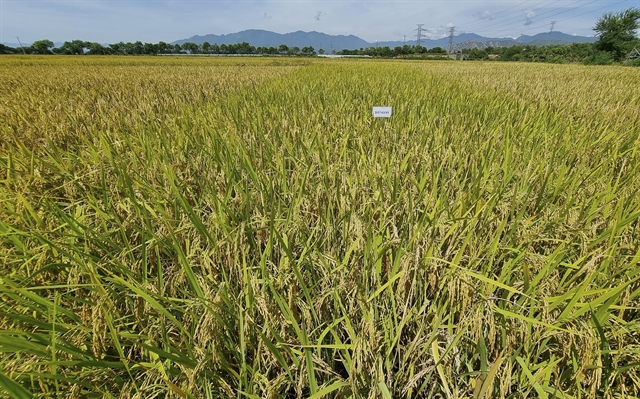 Society
Society

The Tây Nguyên (Central Highlands) and coastal south-central regions have both expanded the area under summer-autumn rice and increased yields.

|
| Rice fields planted to clean and high-quality standards in Ninh Thuận Province’s Ninh Sơn District. — VNA/VNS Photo Nguyễn Thành |
NINH THUẬN — The Tây Nguyên (Central Highlands) and coastal south-central regions have both expanded the area under summer-autumn rice and increased yields.
They planted 181,000ha, nearly 1,000ha more than last year, and harvested 6.3 tonnes per hectare, 1.65 tonnes higher, according to the Ministry of Agriculture and Rural Development.
The coastal south-central region accounted for a lion’s share of more than 176,000ha.
They also planted more than 272,000ha of rice in the rainy season which normally lasts between May and November, and increased the yield by a tonne to 5.3 tonnes per hectare.
Speaking at a seminar in Ninh Thuận Province recently, Nguyễn Như Cường, head of the ministry’s Plant Cultivation Department, attributed the improved results to co-operation between various central and local agencies to proactively organise suitable cultivation schedules in each locality.
This has helped farmers secure irrigation water, mitigate the impacts of pests and reduce costs, he said.
The increased awareness among farmers about using high-quality seeds and advanced farming techniques has improved yields and output, he said.
The provinces in the regions have repaired and upgraded irrigation canals and reservoirs to ensure sufficient irrigation, and efficiently forecast disease outbreaks to help farmers prevent losses.
The regions’ agriculture has developed but its scale and output are not comparable with a Hồng (Red River) Delta in the northern region, Cửu Long (Mekong) Delta or the south-east, participants told the seminar.
Their rice farming is not very efficient or stable because of the small scale and lack of linkages between farmers, which pose difficulties for the transfer of advanced farming techniques to them, post-harvest preservation and processing.
Unfavourable weather, unreliable demand because of the impacts of COVID-19, high prices of inputs, and a shortage of workers have sent costs spiralling for farmers.
However, many provinces in the two regions have proactively restructured crop cultivation to suit the local weather, soil and water conditions to mitigate the situation.
Nguyễn Thị Tố Trân, deputy director of the Bình Định Province Department of Agriculture and Rural Development, said the south-central province has switched to high-value crops on more rice fields.
“The conversion has achieved high efficiency and high value.”
In these fields farmers now grow peanut, vegetables, corn and others, and authorities have helped develop linkages among farmers and agricultural companies.
Deputy Minister of Agriculture and Rural Development Lê Quốc Doanh said many provinces in the two regions have expanded farming areas and effectively restructured cultivation.
Their weather has been unseasonable, with unusual levels of rain and resultant flooding, and so cultivation schedules for the winter-spring crop should be organised meticulously, he said.
The winter-spring rice crop is around the corner, and the Tây Nguyên region plans to plant it on 93,000ha and the coastal south - central region, 326,000ha, according to the Plant Cultivation Department.
Doanh said they should sow short-term, high-quality rice varieties.
The department has instructed the two regions to plant the crop between December 10 and 31 to secure enough water for irrigation.
In the south-central provinces of Bình Định, Khánh Hoà, Ninh Thuận, and Bình Thuận and the Central Highlands province of Lâm Đồng, the sowing should begin by mid-November in localities that cannot secure sufficient water at the end of the crop, it added. — VNS




